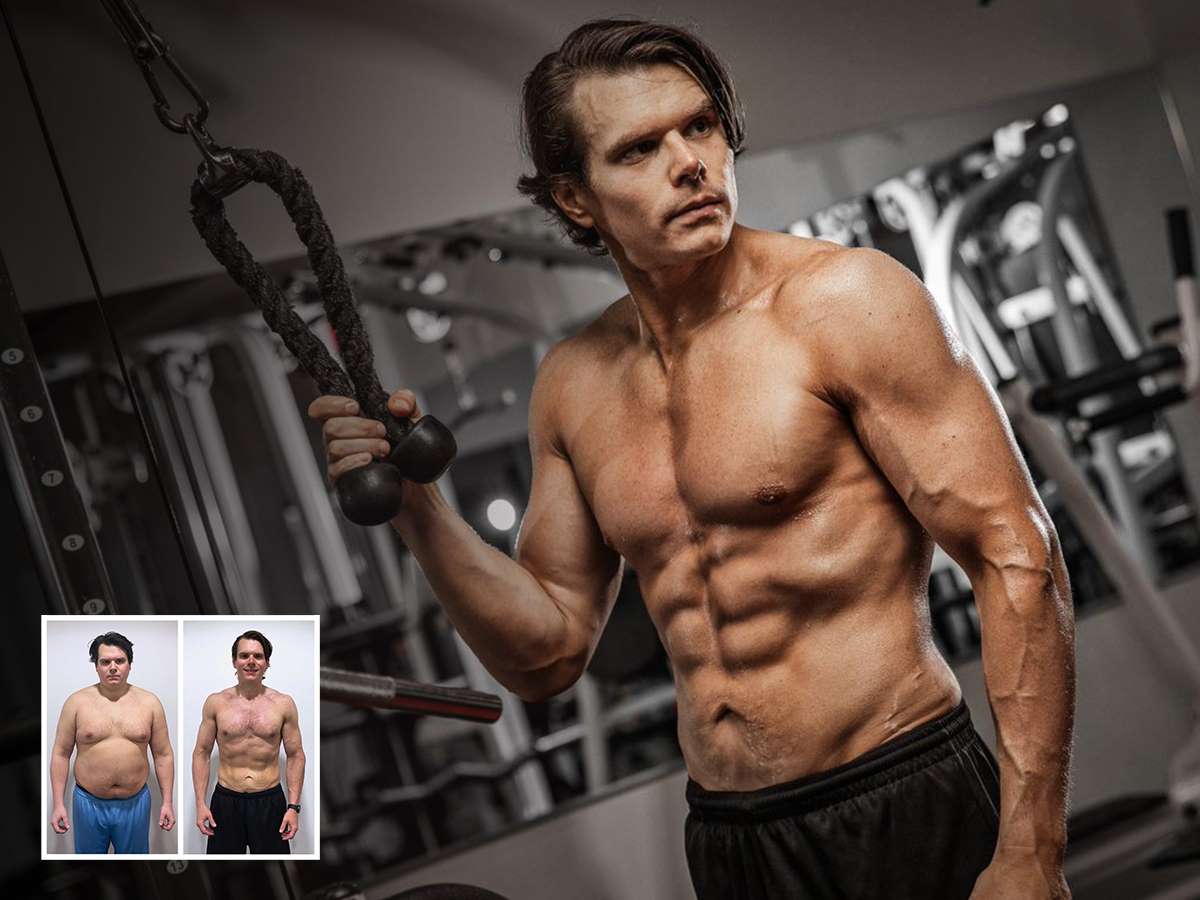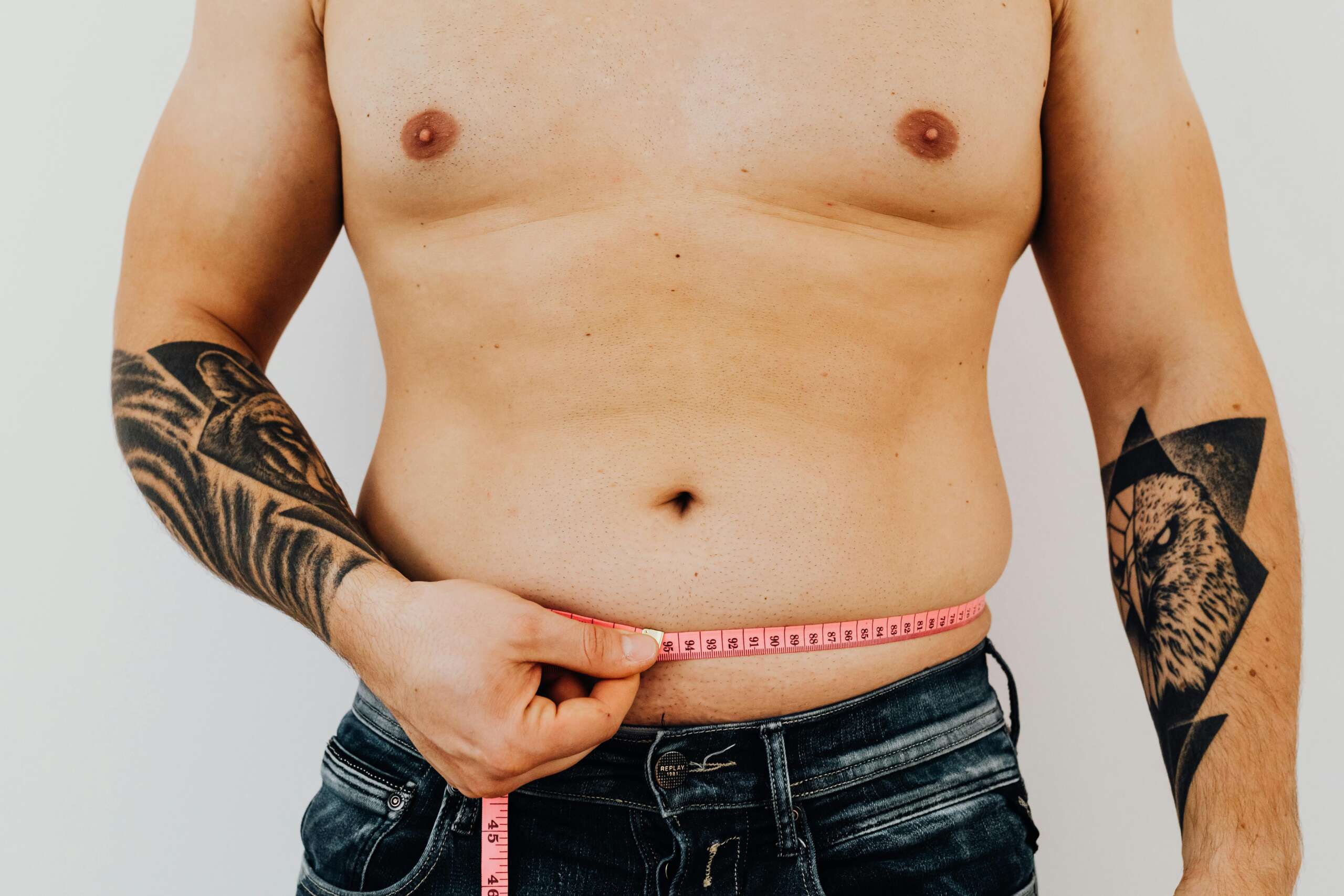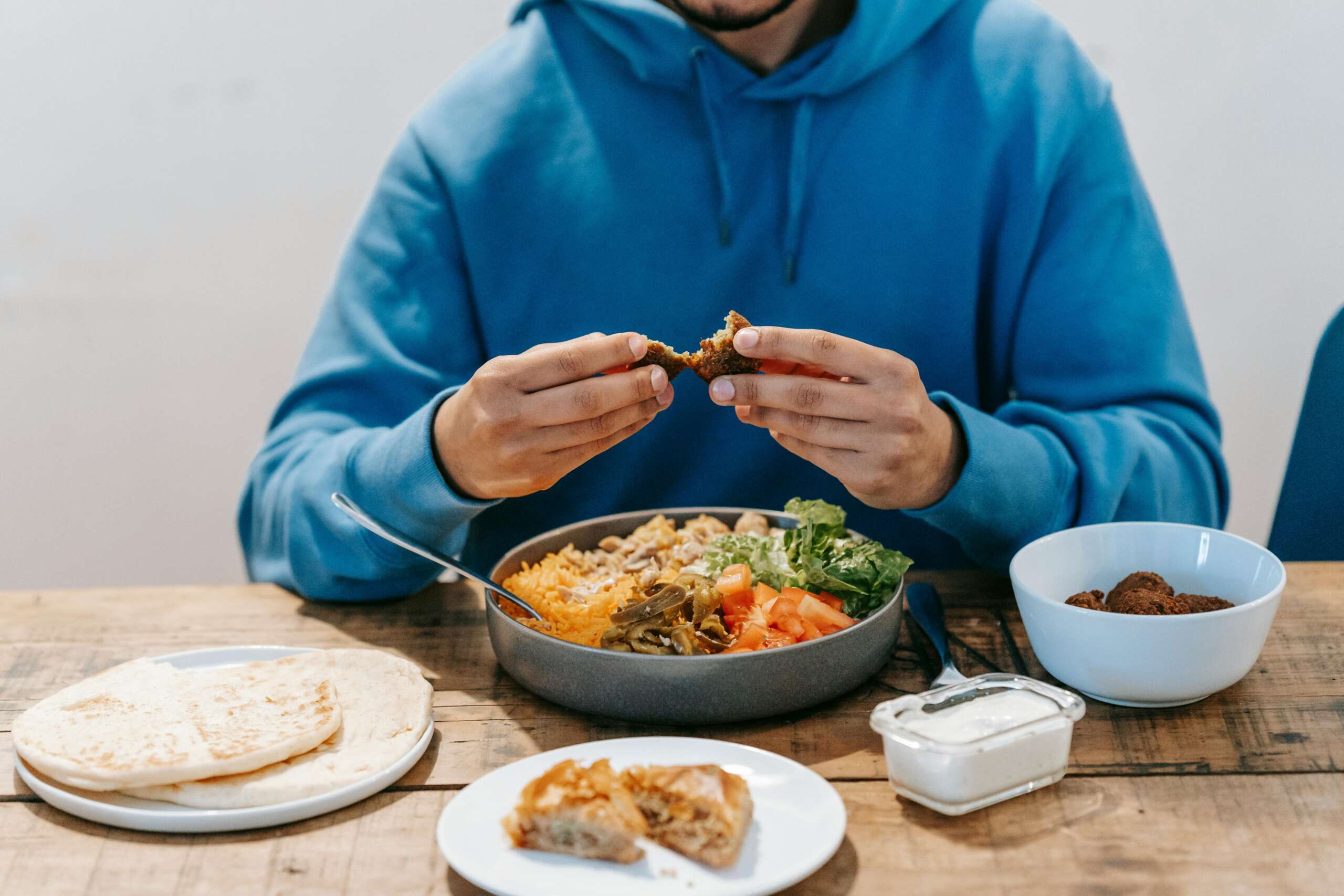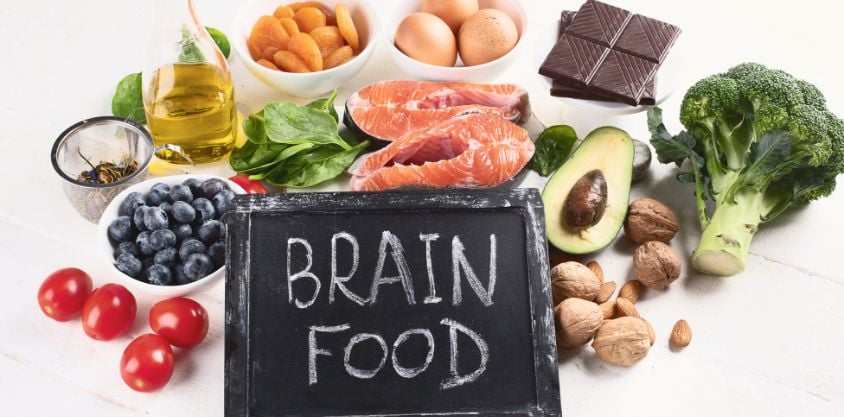The ‘dad bod’ isn’t just a harmless stereotype. It’s a warning sign – a combination of rising belly fat, shrinking muscle, and declining energy that creeps in when fatherhood pushes fitness to the bottom of the list.
This isn’t solely about how you look. It’s about how you feel, how you perform, and how long you stay healthy for your family members who rely on you. Extra weight means less energy, lower confidence, and a higher risk of serious health issues like heart disease and diabetes.
The good news is that it’s completely avoidable. Thousands of fathers who have worked with us at Ultimate Performance have proven that with the right strategy – built around strength training, simple nutrition, and specific lifestyle habits – you can ditch the dad bod, stay strong, and become the role model your family deserves.
This guide will show you how. You’ll learn how to train efficiently, eat smart, and stay feeling lean and energised – no matter how busy fatherhood gets.

Table of Contents
ToggleWhat is a dad bod (and why it happens)
The ‘dad bod’ is the nickname for the physical consequence of neglecting the habits that keep men lean, strong, and healthy – most commonly triggered by the demands of fatherhood.
It typically shows up as an increase in belly fat, muscle loss, lower strength, and a general feeling of being heavier and more sluggish than you used to be. It happens because the things that previously kept you fit – regular training, good nutrition, quality sleep, and stress management – are often the first to fall apart when the pressure of raising kids collides with work and family life.
The physiology is simple. Less strength training leads to muscle loss. Poor sleep elevates hunger hormones and stress hormones like cortisol, which drive fat storage, particularly around the waist [1]. Convenience foods, fewer (or no) workouts, and extra calories from alcohol compound the problem. What starts as “just a few pounds” can quickly become a permanent fixture – unless you act.
This is not just about the way you look. Excess belly fat, especially visceral fat stored around your organs, is directly linked to higher risks of cardiovascular disease, diabetes, stroke, depression and lower life expectancy [2]. A dad bod is a warning sign that your health, energy, and vitality are slipping away.
And this isn’t theoretical. At Ultimate Performance, we’ve analysed the data from thousands of male clients we’ve worked with over the past decade and found a clear trend:
-
- Waist size starts creeping into the ‘at risk’ zone by age 35-36. On average, men cross the 94cm threshold around this point – the line that marks increased risk for metabolic syndrome (the umbrella term for a cluster of conditions that increase the risk of heart disease, stroke, and type 2 diabetes).
-
- Over 60% of men aged 35+ begin their transformation in the ‘at risk’ or ‘high risk’ category. For men aged 35–50, between 60% and 74% had a waist above 94cm when they joined us.
-
- That excess waistline isn’t just a cosmetic concern. Central obesity is linked to a shorter lifespan – studies show men with a waist over 102cm have up to a 5-year reduction in life expectancy. [13]
-
- But the great news? The dad bod is reversible. Our data shows men aged 30 to 50 lose an average of 8.5–9.4cm from their waist – roughly two jeans sizes – with the proper training, targeted nutrition, and lifestyle interventions.
- Nearly 40% of men move down at least one risk category – from high to at-risk, or from at-risk to healthy – after their transformation. That’s not just weight loss. That’s lowering your disease risk and adding years to your life.

The 10-second ‘dad bod’ tape measure test: Are you at risk?
You don’t need a fancy scan or a complicated formula to know if your health is at risk. Just a tape measure and 10 seconds.
Wrap it around your waist at the belly button (not your trousers) and check the number:
-
Under 94cm? You’re in the healthy zone.
-
Between 94cm and 102cm? You’re at increased risk.
-
Over 102cm? You’re in the high-risk category for metabolic syndrome – which raises your chances of heart disease, stroke, and type 2 diabetes.
Even if your BMI is normal, a large waist can spell trouble. In fact, one study found that men with normal BMI but large waists (so-called ‘skinny fat’) had twice the mortality risk of those with healthy waistlines [14].
But here’s the kicker: reducing your waist by 10cm could extend your life by up to 2 years [15]. And many of our clients achieve that within three months.

Is the dad bod inevitable? (Myth vs reality)
The myth that the dad bod is an unavoidable part of fatherhood is exactly that – a myth.
Yes, the responsibilities of parenthood change your routine. Sleep gets disrupted. Free time becomes a luxury. Priorities shift. But none of this means that gaining weight, losing muscle, or watching your fitness fade away is automatic or irreversible.
What’s often mistaken as ‘inevitable’ is really just the result of small, compounded decisions – skipping workouts, relying on convenience foods, cutting corners on sleep, or using alcohol to unwind. Left unchecked, these habits gradually chip away at your physique, energy levels, and long-term health.
It isn’t biology or genetics, it’s simply the absence of a fitness strategy.
When fitness drops down the priority list, the outcome is predictable. But when a simple, realistic framework is in place – one built around strength training, smarter nutrition, and lifestyle adjustments that work for a busy father — the results are just as predictable in the other direction.
Thousands of fathers have proven that staying lean, strong, and healthy with kids is entirely possible. The dad bod is common, but it’s not compulsory.
The health risks of the dad bod
The dad bod is typified by carrying excess fat, particularly around the midsection. It signals a shift towards poorer metabolic health, lower physical performance, and greater long-term risk of chronic disease.
Sleep deprivation = fat gain and low energy
Sleep deprivation is one of the most common – and underestimated – health disruptors for new dads.
Research shows that 56% of new fathers fall into negative health behaviours within the first 12 months after their child is born, with poor sleep being the primary driver [11]. This isn’t just anecdotal – it has measurable effects on body composition and performance.
Even a sleep deficit of just two hours per night has been shown to impair fat loss and accelerate muscle breakdown during dieting [4]. When sleep drops below six hours, these effects become even more pronounced.
Sleep loss increases levels of ghrelin (the hunger hormone), reduces leptin (the satiety hormone), and elevates cortisol – a stress hormone that encourages fat storage around the midsection [1]. The result? You’re more likely to overeat, less likely to train, and less capable of recovering when you do.
And it’s not just about energy or fat gain. Sleep deprivation weakens motivation, mood, immunity, and your ability to stay consistent. For dads aiming to get leaner and stronger, improving sleep quality is a force multiplier.
Stress = belly fat, low motivation, poor recovery
Fatherhood adds an entirely new layer of pressure. Balancing the emotional demands of parenting with work, finances, and minimal downtime can significantly increase stress levels.
That stress doesn’t just live in your head – it has a direct, measurable impact on your body. Chronically elevated cortisol (your primary stress hormone) drives belly fat storage, disrupts recovery, impairs muscle growth, and lowers your capacity to train hard or consistently.
Over time, chronic stress has been linked to a wide range of serious health consequences – including increased risk of heart disease, diabetes, and accelerated ageing. It also plays a significant role in the onset of depressive disorders [3].
What’s more, stress often leads to short-term coping behaviours that make things worse: skipping workouts, drinking more alcohol, relying on ultra-processed food, and cutting corners on sleep. Each of these feeds the cycle of weight gain, fatigue, and frustration.
If you want to stay lean, strong, and energised, stress management isn’t a ‘nice to have’. It’s a non-negotiable part of your training and health strategy.
 Chronic stress can lead to poor sleep and relying on unhealthy coping mechanisms like drinking alcohol or eating processed foods which exacerbate weight gain.
Chronic stress can lead to poor sleep and relying on unhealthy coping mechanisms like drinking alcohol or eating processed foods which exacerbate weight gain.
Less exercise = muscle loss and weight gain
New fathers lose an average of five hours of physical activity per week compared to their pre-parenthood baseline [4]. That drop has real consequences – not just physically, but mentally. Reduced movement is linked to higher risk of heart disease and a sharp decline in mental wellbeing [2].
Muscle is metabolically active. When you stop training, you don’t just lose strength – you reduce your body’s ability to burn calories. Without resistance training, muscle mass declines, your metabolic rate slows, and fat storage increases. This creates the perfect environment for the dad bod to take hold.
Regular strength training reverses that trend. It preserves and often builds muscle, which increases your metabolic rate, and forms the foundation of a physique that performs as well as it looks.
 Exercising less and becoming more sedentary is another factor contributing to the ‘dad bod’.
Exercising less and becoming more sedentary is another factor contributing to the ‘dad bod’.
Your habits affect your kids’ future health
The dad bod doesn’t just affect you. Your children are watching what you do and how you live – and copying.
Fathers often act as the physical activity role models in a household. Studies show that kids mimic their parents’ eating, movement, and lifestyle habits from a young age. Over time, that modelling adds up.
In fact, research has shown that children with an obese father are 14 times more likely to become obese in their teens – even when the mother is a healthy weight [6].
These early influences shape a child’s relationship with food, fitness, and self-care for life. A father who leads by example – staying strong, eating well, managing stress, and living an active life every day – gives his kids the best foundation for long-term health.
You’re not just training for yourself. You’re setting the standard for the next generation.
 Children mimic their parents habits – for better or for worse.
Children mimic their parents habits – for better or for worse.
5 simple strategies to avoid the dad bod
Avoiding the dad bod doesn’t require perfection – it requires a practical, repeatable framework built around strength training, better nutrition, and consistent habits that work in the real world.
The following five strategies have helped thousands of busy fathers we’ve worked with at Ultimate Performance to ditch the extra weight, regain their energy, and become stronger, more resilient role models for their families – without sacrificing precious family time.
1. Prioritise strength training (short and effective)
Strength training is the single most effective tool to fight fat gain, preserve muscle, and maintain a high metabolism as a busy dad. The mistake most men make is assuming they need long, exhausting gym sessions to see results. You don’t.
A well-structured strength workout can be completed in 45 minutes, three to four times a week – whether that’s in the gym, or at home. Focus on compound lifts like squats, presses, rows, and deadlifts. These movements hit multiple muscle groups, burn more calories, and provide the most ‘return’ on time invested in terms of muscle fibres targeted.
When time is tight – and it will be as a dad – this is non-negotiable. Muscle is the engine that keeps fat gain at bay. Neglect it, and the dad bod can quickly take over.
Strength training is the most effective way to fight fat gain, preserve muscle mass, and maintain a high metabolism – especially as a busy dad.
The common mistake is believing that results require long, exhausting workouts. They don’t.
Three to four focused strength sessions per week, lasting around 45 minutes, is more than enough to drive body recomposition (building muscle, and losing fat). Prioritise compound movements like squats, deadlifts, presses, and rows. These target multiple muscle groups, stimulate more growth, and deliver the highest return on time invested in the gym.
When your schedule is under pressure, strength training is essential – and it’s the most time-efficient way of getting results. Neglect it, and muscle loss, weight gain, and energy dips are almost guaranteed to follow. Here are 10 golden rules for weight training men over 40 should follow.

Weight training is an effective way to transform your body composition.
2. Simplify your nutrition (stop relying on takeaways)
Nutrition is where most new dads struggle. When energy is low, takeaway food and processed snacks become the default. But these choices have real consequences.
High consumption of ultra-processed food is strongly linked to weight gain, high waist circumference, and metabolic syndrome – a cluster of risk factors for heart disease, stroke, and type 2 diabetes [8].
The solution doesn’t have to be complicated diet plans or macro tracking spreadsheets. The best way forward is simplicity and consistency with your nutrition.
Build repeatable meals around lean protein, vegetables, and a controlled portion of fats or carbs. Keep go-to staples like rotisserie chicken, microwaveable rice, eggs, Greek yoghurt, and frozen veg ready to go. Prepare your meals ahead of time, batch-cooking when possible and freeze extra portions.
Just one hour of activity per week has been shown to improve mood and mindset [7] – and the same applies to fuelling your body. Smart nutrition doesn’t need to be perfect, but it does need to support your energy, decision-making, and training results.
Your mantra should be ‘eat to perform at your best – both in the gym and at home’.
 Focusing on whole foods like lean protein, vegetables, healthy fats and carbohydrates is key to combatting the onset of weight gain in middle age.
Focusing on whole foods like lean protein, vegetables, healthy fats and carbohydrates is key to combatting the onset of weight gain in middle age.
3. Cut out the bedtime booze
For many new dads, a nightly drink can become a coping mechanism – a way to unwind after a chaotic day. But the cost goes far beyond a few extra calories.
Alcohol consumption is one of the most common negative health behaviours among new fathers, particularly in the first year after a child is born [9]. What feels like harmless relaxation quickly turns into a barrier to fat loss, recovery, and progress.
Alcohol disrupts sleep quality, lowers testosterone, impairs muscle repair, and ramps up cravings for sugar and processed food the following day [10]. It weakens your body’s ability to recover, train, and stay lean – and can quickly become a nightly habit that sets progress in reverse.
Reducing alcohol to just social events – or cutting it out entirely – is one of the fastest ways to improve energy, fat loss, and sleep quality. Your body will thank you, and so will your results
 Reducing or eliminating alcohol intake can make a big difference.
Reducing or eliminating alcohol intake can make a big difference.
4. Stay active with your kids (walks, play, micro-workouts)
Not every workout has to be inside a gym. Daily movement outside of structured training, known as NEAT (Non-Exercise Activity Thermogenesis) plays a huge role in increasing your daily calorie burn and keeping fat off. This is where being a dad can actually work in your favour.
Push the pram for an hour-long walk while your partner rests. Play active games at the park. Carry the baby in a sling while moving around the house.
Research also shows that exposing your baby to natural daylight and outdoor walks helps them settle into a regular sleep rhythm faster, which benefits both of you [11], [12], [13].
Even short 10 to 15 minute bodyweight circuits at home – squats, push-ups, lunges – can fill the gaps when gym time isn’t possible.
Every bit of movement counts. It’s not just training time that keeps you lean – it’s your total daily activity.
 Daily activities beyond exercise are important to increase overall energy expenditure and support fat loss.
Daily activities beyond exercise are important to increase overall energy expenditure and support fat loss.
Sleep better even with a newborn (optimise quality)
You may not be able to control how many hours you sleep, but you can control the quality of the sleep you get.
Invest in blackout blinds or an eye mask to eliminate light. Use white noise to drown out environmental distractions. Avoid caffeine after mid-afternoon and switch off screens in the final hour or two before bed to help wind the nervous system down.
Where possible, split night duties with your partner strategically. If one of you is bottle feeding, alternate shifts so each gets a block of uninterrupted sleep. If breastfeeding, the other parent handles early mornings or household tasks to balance the load.
These small adjustments not only improve mood and energy, they directly impact fat loss, muscle retention, and how well your body handles stress [9].

Improving sleep quality is a strategy we use to enhance the results we achieve with the dads we work with at Ultimate Performance.
New dad FAQs: Your biggest questions answered
Do men gain weight after having kids?
Yes – and it’s more common than most realise. Studies show that new fathers gain an average of 4–5kg (9-11lbs) within the first year after having children [10]. This isn’t the result of a mysterious biological shift. It’s down to lifestyle changes – less exercise, poorer sleep, higher stress, and convenience-driven eating. The good news is that this isn’t inevitable. With the right training and nutrition strategies, that weight gain can be prevented – or reversed.
How can I find time to train as a busy dad?
Time doesn’t magically appear. It has to be created by deciding that your health is non-negotiable. This doesn’t mean you need to spend hours in the gym every day. Short, focused strength sessions – 45 minutes, three to four times a week – are enough to maintain muscle and drive fat loss.
It often means blocking out time in the diary the same way you would for meetings or family commitments. Whether that’s before the kids wake up, during a lunch break, or after bedtime, the key is consistency, not perfection.
How long does it take to lose the dad bod?
There’s no one-size-fits-all answer. But for most men, meaningful progress happens within 8 to 12 weeks of consistent training and nutrition. At Ultimate Performance, many fathers achieve dramatic transformations within this timeframe — losing 10–15kg, dropping body fat, and dramatically improving their energy, mood, and strength.
The timeline depends on starting point, adherence, and how aggressively you apply the principles. But results are far faster than most expect when the right systems are in place.
Is the dad bod really unhealthy?
Absolutely. Carrying excess belly fat is a serious health risk. Visceral fat – the fat stored around your organs – is directly linked to higher risks of heart disease, stroke, type 2 diabetes, and early death [2].
Beyond the physical risks, it impacts energy, sleep, mood, and productivity. The longer it’s ignored, the harder it becomes to reverse.
Can I get fit without giving up beer, pizza, or time with my kids?
You can get lean and strong without living like a monk – but it does require trade-offs and sacrifices. Occasional treats like pizza or a beer can be fine within a structured plan. What isn’t compatible is using food or alcohol as a daily crutch for stress or exhaustion.
What most dads discover is that feeling fit, strong, and energised is far more rewarding than short-term comfort eating. With efficient workouts, smarter nutrition, and better habits, you don’t have to choose between being fit and being present for your family. You can – and should – have both.
Client case study:
How Dan lost 35kg as a new father
Dan was in exactly the position most new dads find themselves. Long working hours, broken sleep, family responsibilities – and a body that was slowly sliding in the wrong direction.
At his heaviest, Dan weighed 111kg (245lbs). Energy was low, stress was high, and the creeping impact on his health and confidence was becoming impossible to ignore.
When he joined Ultimate Performance, Dan didn’t have the luxury of endless gym hours or complicated meal plans. What he had was a clear goal – to become the healthiest, strongest version of himself for his family – and a proven framework to follow.
Through focused strength training three times a week, a simple, repeatable nutrition strategy, and focusing on good recovery wherever possible, Dan completely transformed his physique, achieving an impressive 35kg (77lbs) weight loss. Visible abs for the first time in years. More energy, better mood, sharper focus at work – and, most importantly, the ability to be a more active, present father.
Dan’s story isn’t an exception. It’s what happens when busy dads stop waiting for the perfect moment and start taking action with a plan designed around their reality.

Dan dropped 35kg (77lbs) and became a more energetic, present father. Read how he did it here.
Conclusion: a fitter dad is a better dad (take control today)
The dad bod is not a badge of honour. It’s not an inevitable consequence of fatherhood. It’s a reflection of what happens when health slips down the priority list.
But it doesn’t have to stay that way.
Thousands of fathers have proven that it’s possible to reclaim their fitness, their energy, and their health – not by chasing perfection, but by following a simple, sustainable plan built around strength training, nutrition, and lifestyle habits that work alongside family life.
Looking good isn’t the singular goal. It’s equally about having the energy to show up fully for your kids, for your partner, and for yourself. It’s about becoming the role model your children need in a father figure. A fitter dad is a better dad – one who’s present, hands-on, and prepared to lead by example.
The only thing standing between you and that outcome is action.
References
[1] Cleveland Clinic (2023). Visceral Fat: What It Is & How to Get Rid of It. https://my.clevelandclinic.org/health/diseases/24147-visceral-fat
[2] Young, M.D., & Morgan, P.J. (2017). Paternal Physical Activity: An Important Target to Improve the Health of Fathers and Their Children. American Journal of Lifestyle Medicine. https://pubmed.ncbi.nlm.nih.gov/30202332
[3] Rasheed, N. (2016). Prolonged Stress Leads to Serious Health Problems: Preventive Approaches. International Journal of Health Sciences. https://pubmed.ncbi.nlm.nih.gov/27004066/
[4] Nedeltcheva, A.V., et al. (2010). Insufficient Sleep Undermines Dietary Efforts to Reduce Adiposity. Annals of Internal Medicine. https://pubmed.ncbi.nlm.nih.gov/20921542
[5] Dimova, E., et al. (2021). Exploring Men’s Alcohol Consumption in the Context of Becoming a New Father: A Scoping Review. Drugs: Education, Prevention and Policy. https://www.tandfonline.com/doi/full/10.1080/09687637.2021.1951669
[6] Van Thiel, D.H., & Lester, R. (1979). The Effect of Chronic Alcohol Abuse on Sexual Function. Clinics in Endocrinology and Metabolism.
[7] Pagliai, G., et al. (2021). Consumption of Ultra-Processed Foods and Health Status: A Systematic Review and Meta-Analysis. British Journal of Nutrition. https://pubmed.ncbi.nlm.nih.gov/32792031
[8] Harvey, S.B., et al. (2017). Exercise and the Prevention of Depression: Results of the HUNT Cohort Study. American Journal of Psychiatry. https://pubmed.ncbi.nlm.nih.gov/28969440
[9] Barion, A., & Zee, P.C. (2007). A Clinical Approach to Circadian Rhythm Sleep Disorders. Sleep Medicine. https://pubmed.ncbi.nlm.nih.gov/17625947
[10] Gallaher, K.G.H., et al. (2018). The Role of Circadian Rhythms in Postpartum Sleep and Mood. Sleep Medicine Clinics.
https://pubmed.ncbi.nlm.nih.gov/30098753/
[11] Ipsos MORI (2019). Fatherhood and Social Connections. Movember Foundation. https://cdn.movember.com/uploads/images/News/UK/Movember%20Fathers%20%26%20Social%20Connections%20Report.pdf
[12] Yates, J. (2018). Perspective: The Long-Term Effects of Light Exposure on Establishment of Newborn Circadian Rhythm. Journal of Sleep Medicine Clinics.
[13] Ashwell M, Gibson S. Waist-to-height ratio as an indicator of ‘early health risk’: simpler and more predictive than using a ‘matrix’ based on BMI and waist circumference. BMJ Open. 2016;6(3):e010159.
https://bmjopen.bmj.com/content/6/3/e010159
[14] Sahakyan KR, et al. Normal-Weight Central Obesity: Implications for Total and Cardiovascular Mortality. Ann Intern Med. 2015;163(11):827–835.
https://doi.org/10.7326/M14-2525
[15] Pischon T, et al. General and Abdominal Adiposity and Risk of Death in Europe. New England Journal of Medicine. 2008;359:2105–2120.
https://www.nejm.org/doi/full/10.1056/NEJMoa0801891
The post How to avoid the ‘dad bod’: Fitness, nutrition, and workout tips for busy dads appeared first on Ultimate Performance Blog.
Source link











